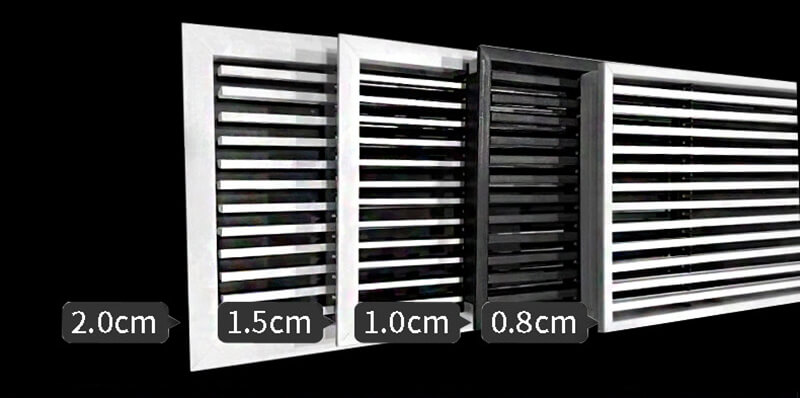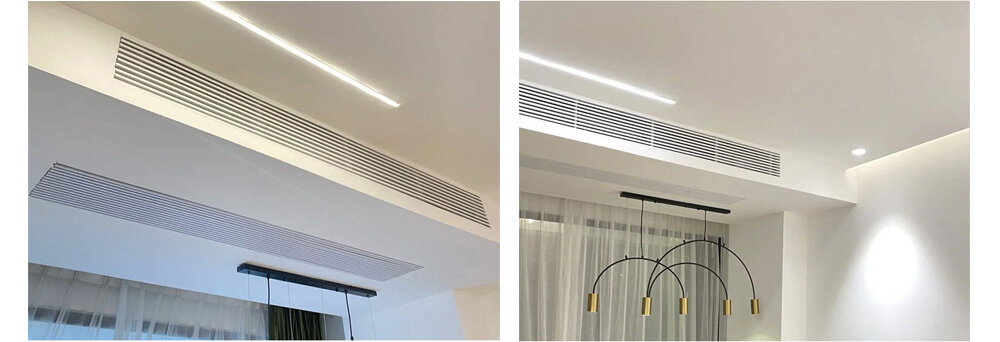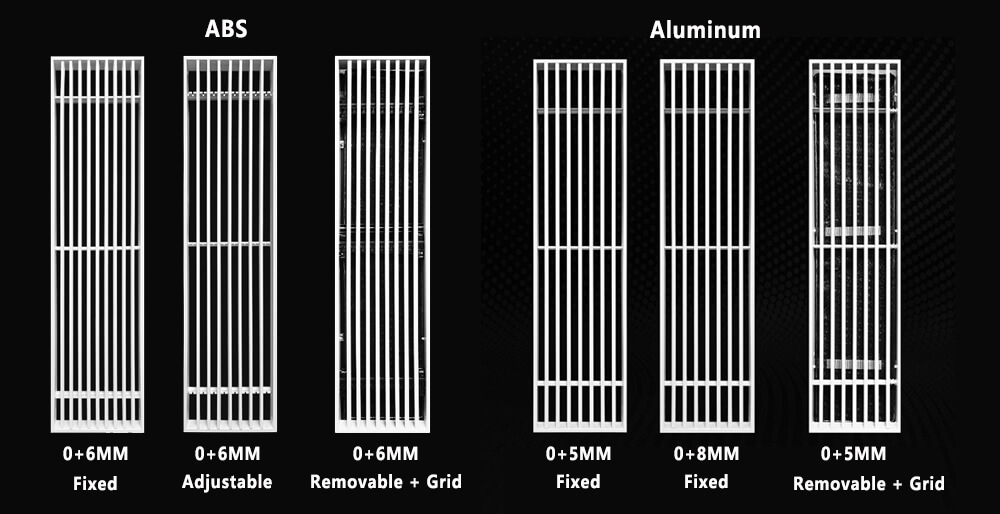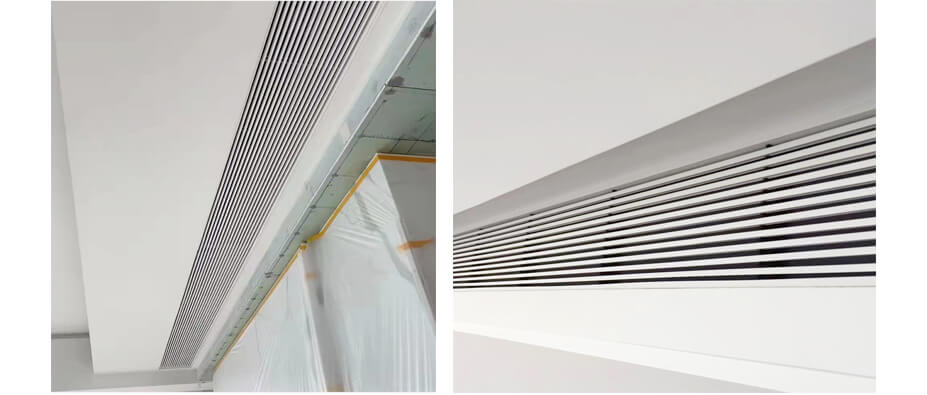Basic introduction of HVAC Linear Bar Grilles
Discover the pinnacle of air management with our premium Linear Bar Grille Diffusers, ingeniously designed for superior endurance and performance without compromising on visual appeal. These grilles set the standard for excellence, merging seamlessly with the rigorous demands of both the architectural and HVAC fields.
Key Features of Our Linear Bar Grille Diffusers:
- Personalization: Each grille is crafted with precision, offering a slew of design and frame choices, inclusive of custom curvature to accommodate any architectural detail.
- Material Excellence: We utilize only the finest materials, ranging from sturdy aluminum to elegant bronze and sleek stainless steel, ensuring your grille stands the test of time.
- Finish Variety: Choose from an assortment of finishes to achieve the desired look, including our classic powder-coated white for a crisp, clean appearance.
- Design Flexibility: Our grilles are equipped with design enhancements like angled edges and corner joints, ensuring a perfect match for any project specification.
- Custom Sizing: Tailored dimensions with strict tolerances ensure a precise fit for every application.
- Blade Variations: Select from a spectrum of blade angles, including neutral, 15, or 30 degrees, to fine-tune airflow distribution.
- Effortless Fit: Ideal for an array of placements, our grilles are constructed for straightforward installation in walls, floors, and ceilings, ensuring seamless integration.

Detailed Specifications:
- Build Options: Ranging from standard to heavy-duty builds, our selection caters to diverse structural requirements.
- Blade Measurements: Assorted blade spacings and widths are available, offering exacting control over airflow.
- Safety Assured: Our products are finished to eliminate sharp edges, providing safety and ease during installation.
- Durability: The powder-coat finish not only looks good but is also resistant to scratches, maintaining its pristine condition over time.
- Secure Packaging: We go the extra mile to inspect and package each grille, safeguarding against transit damage for assured quality upon arrival.
- Optimized Ventilation: These grilles are engineered to support your HVAC system’s efficiency with unhindered air movement.
Our Assurance:
- Anodized Finish: Our standard anodized finish provides a sophisticated and durable exterior.
- Bar Configuration: The bars are spaciously set at 15 mm from center to center, designed for optimal air passage.
- Framework Support: Grilles come with a robust framework, ready for installation without the need for visible fixing points.
Elevate your space with our exquisitely designed Linear Bar Grille Diffusers, where enduring quality meets innovative customization. Rest assured, every grille is a testament to our dedication to excellence, ready to enhance your project with both style and substance.

| LBF-0 Code | LBF-15 Code | LBF-30 Code | A-A | B-B | H |
| LBF-0 350100 | LBF-15 350100 | LBF-30 350100 | 345*95 | 394*144 | 43 |
| LBF-0 350150 | LBF-15 350150 | LBF-30 350150 | 345*145 | 394*194 | 43 |
| LBF-0 600100 | LBF-15 600100 | LBF-30 600100 | 595*95 | 644*144 | 43 |
| LBF-0 600150 | LBF-15 600150 | LBF-30 600150 | 595*145 | 644*194 | 43 |
| LBF-0 900100 | LBF-15 900100 | LBF-30 900100 | 895*95 | 944*144 | 43 |
| LBF-0 900150 | LBF-15 900150 | LBF-30 900150 | 895*145 | 944*194 | 43 |
| LBF-0 120010 | LBF-15 120010 | LBF-30 120010 | 1195*95 | 1244*144 | 43 |
| LBF-0 120015 | LBF-15 120015 | LBF-30 120015 | 1195*145 | 1244*194 | 43 |
| LBF-0 150010 | LBF-15 150010 | LBF-30 150010 | 1495*95 | 1544*144 | 43 |
| LBF-0 150015 | LBF-15 150015 | LBF-30 150015 | 1495*145 | 1544*194 | 43 |
Basic styles and sizes of HVAC Linear Bar Grilles
If you want to know more, please click below:
- Linear Slot Diffusers – The Ultimate Guide
- HVAC Egg Crate Diffuser: The Ultimate Guide
- HVAC Jet Nozzle Diffuser – AIREVERPEAK
- Air Diffusers vs. Air Grilles: What’s the Difference?
- HVAC Air Swirl Diffusers – AIREVERPEAK
HVAC Linear Bar Grilles – The Ultimate Guide
1. What are the Linear Bar Grilles?
Linear bar grilles are simple construction elements used for covering air vents in buildings. Imagine when air needs to move in or out of a room, like when you have heating, ventilation, or air conditioning (HVAC) systems, you often see grilles on the walls, floors, or ceilings. Linear bar grilles are just that: they have straight, parallel bars that can be horizontal or vertical, and they create a vent cover that allows air to pass through while blocking larger objects from entering the HVAC system.
These grilles are not just functional; they can also be decorative. They come in different materials like aluminum or steel and can be painted or finished to match the room’s decor. Their design ensures that the air is spread out evenly, and sometimes you can adjust the bars to control the direction of the airflow.
Linear bar grilles are metal covers with rows of bars you see over air duct openings, helping to manage and direct airflow in a room while also looking neat and tidy.
2. What size is a linear bar grille?
A linear bar grille is a component that you can find in ventilation systems. It’s not one-size-fits-all because it needs to fit different spaces and serve various airflow requirements. So, the size of a linear bar grille can vary. It might be as small as a few inches in length and width for a home air conditioning system, or it could be several feet long for commercial buildings.
When you need to pick a size, think about where it will go and how much air needs to go through it. It’s like choosing a door for a room. A closet might need a small door, while a garage would need a much bigger one. The same goes for the grille – its size is based on the space it serves.
For a precise fit, the size is usually described by its length and height. For example, you might see a grille that’s 24 inches long and 6 inches high. That’s a common size for residential use. But if you’re dealing with a big space like a shopping center, the grilles can be much larger.
Always measure the space where you’re going to put the grille before you buy one. This ensures you get the right size that fits perfectly and works efficiently.

3. What is the free area of the linear bar grille?
When we talk about the “free area” of an HVAC linear bar grille, we’re referring to the part of the grille that air can pass through. Imagine you have a window with bars – the free area would be the gaps between the bars where nothing is blocking the view.
For the grille, the bars and the frame take up some space, so the free area is the total space of the grille minus the space taken up by the bars and the frame. This area is important because it tells you how much air can flow through the grille into a room.
To find out the free area, you would:
- Measure the total area of the grille (length x height).
- Then, subtract the area covered by the bars and the frame.
This calculation gives you the free area in square inches or square centimeters, depending on your measurement units. The larger the free area, the more air can flow through the grille and the more effective it can be for ventilation purposes.
4. What is the purpose of a linear bar grille?
A linear bar grille is like a cover with slits that you put over the openings where air comes into a room from your heating and cooling system. Its job is to:
- Guide the air: It helps direct the air coming into a room in a certain direction, so it flows where it’s needed.
- Look good: It’s designed to be nice to look at and fit in with the room’s style.
- Keep stuff out: It stops things like dust, toys, or anything else that might block the airway.
- Control flow: You can adjust some grilles to change how much air comes in or to close off the air when it’s not needed.

5. How many types of linear bar grilles are in HVAC?
- Fixed Bar Grilles: These have bars that stay in one place and don’t move. They’re good for simple, no-fuss air direction.
- Adjustable Bar Grilles: These let you move the bars to change where the air goes. It’s like being able to point a fan in different directions.
- Return Grilles: These are the ones that suck air back to be heated or cooled again. They’re like the system’s way of recycling air.
- Supply Grilles: Opposite of return grilles, these blow the treated air into the room. Think of them as the fresh air delivery guys.
- Floor Grilles: These are tough enough to walk on since they’re on the floor. They spread air up into the room from down below.
- Sidewall Grilles: You’ll find these on walls, usually blowing air across the room to get a good mix.
- Ceiling Grilles: These come from above and can be good for spreading air evenly throughout the room.

6. What material are the linear bar grilles?
Linear bar grilles can be made from several kinds of materials, and each type has its own perks. Here are a few of the common ones:
- Aluminum: This is a popular choice because it’s lightweight and doesn’t rust. So it’s great for places where it might get a bit damp or where you don’t want something heavy hanging on the wall or ceiling.
- Steel: This is super strong and can handle a lot of wear and tear. It’s a good pick for places like floors, where grilles need to be tough enough to walk on.
- Stainless Steel: Like regular steel, this is strong, but it’s also resistant to rust and looks shiny and modern, which can be a nice touch for fancier spaces.
- Plastic: This one’s good if you’re watching your wallet and want something that won’t rust. Plus, it can come in lots of colors to match your room.
- Wood: If you’re going for a classic or elegant look, wood grilles can blend in nicely with hardwood floors or furniture.

7. Where can you use the linear bar grilles?
Linear bar grilles can be used in lots of different places around a building where you need to control the flow of air. You can use them in any room where you need air to move around, like in homes, offices, stores, and other places where people hang out and want to stay comfy. Here are some common spots:
- Ceilings: They can be installed up top to spread air evenly throughout a room.
- Walls: Putting them at the side can help push air across a space.
- Floors: They’re tough enough for foot traffic and can send air up from the ground.
- Under Windows: This spot helps counteract the cold air that can seep in from the glass.
- Near Doors: They can manage the air coming in or going out around doorways.

8. What are the advantages of the linear bar grilles?
Linear bar grilles come with a bunch of perks that make them a sweet choice for moving air around in buildings. Here’s the lowdown on their good points:
- Sleek Design: They look neat and tidy, so they can fit into all sorts of room styles without sticking out like a sore thumb.
- Direction Control: You can angle the bars to push the air exactly where you want it to go. It’s like aiming a water hose at your garden’s thirsty plants.
- Even Air Spread: They’re pretty good at spreading the air out so you don’t get one super hot or cold spot.
- Durability: Made from tough materials, they can take a lot of bumps and bangs and still keep on trucking.
- Easy to Clean: You can just wipe them down or vacuum over them to keep the dust bunnies at bay.
- Variety: They come in all sorts of materials and sizes, so you can pick the perfect fit for your place.
- Good Airflow: They let a good amount of air through, which means your HVAC system doesn’t have to work as hard to get the air where it needs to go.
9. How is a linear bar grille Installation Process?
Installing a linear bar grille is like putting together a piece of flat-pack furniture — you just need the right tools and a bit of know-how. Here’s a simple step-by-step guide to putting one in:
- Measure Up: First, you’ve got to measure the spot where you want the grille to go. Make sure it’s the right size — not too big, not too small.
- Mark It: Use a pencil to mark where the grille will sit. This is like drawing a map so you know where everything needs to go.
- Cut the Opening: If there’s no hole yet, you’ll need to cut one out where you’ve made your marks. This part’s for the grown-ups, as you’ll need tools like a saw.
- Place the Grille: Fit the grille into the opening you’ve just made. It should slot in nicely and snugly.
- Secure It: Now, you’ll need to screw the grille in place. This keeps it from wiggling around. Use a screwdriver to twist the screws into the corners of the grille, fixing it to the wall or ceiling.
- Check It: Give it a little tug to make sure it’s firmly attached. You don’t want it to fall out when the air starts blowing.
- Finishing Touches: If your grille has adjustable bars, set them to direct the air wherever you want.

10. What is the difference between a linear diffuser and a grille?
The main difference is that a linear diffuser is specifically designed for distributing and directing airflow within a space, whereas a grille is mainly used to allow air to pass back into the HVAC system with minimal restriction, and to a lesser extent, to supply air without particular control over its direction.
Linear Diffuser:
- Purpose: A linear diffuser is designed to distribute air in a particular pattern and direction. It typically spreads air evenly across a wide area to ensure a uniform distribution of temperature.
- Design: Linear diffusers often have a long, narrow shape that can range from several inches to several feet in length. They are designed with a series of blades or vanes that can direct airflow in a particular pattern. These vanes can sometimes be adjusted to control the direction of the airflow.
- Installation: They are usually installed along the perimeter of a room or in the ceiling and are often used in spaces that require a well-distributed air pattern, such as offices or large commercial spaces.
- Aesthetics: Linear diffusers are often selected for their sleek appearance and can be more easily integrated into the architectural design of a room, blending with ceiling or wall features.
- Functionality: They can also handle a high volume of air with minimal noise, making them suitable for environments where noise levels are a concern.
Grille:
- Purpose: A grille is typically used for air return or exhaust—it allows air to flow back to the HVAC system for re-heating, cooling, or venting out of the building. Grilles can also be used for air supply, but they don’t direct the air as effectively as diffusers.
- Design: Grilles are usually composed of multiple slats or louvers, and unlike diffusers, they don’t usually have vanes that can direct airflow. Their design is simpler, focusing more on allowing air to pass through freely with minimal resistance.
- Installation: Grilles can be found in various locations within a space, including on walls, floors, doors, or ceilings, depending on whether they are used for supply, return, or exhaust air.
- Aesthetics: They are more utilitarian in design, although there are decorative options available. Their appearance is often less of a consideration than functionality.
- Functionality: Grilles have less control over airflow compared to diffusers and are mainly used to cover openings where air is drawn back into the HVAC system or expelled from a room.

11. What is the maximum length of a linear diffuser?
The length of a linear diffuser can vary widely depending on the specific application and manufacturer specifications. Typically, they can range from about 1 to 8 feet (30 cm to 2.4 meters) in standard sections. However, for custom applications, they can be made to measure, and sections can be joined to span longer distances, potentially up to 10 feet or more.
When determining the size needed for a space, considerations include the volume of air required, the layout of the space, and aesthetic preferences. Also, you can shoot us a message. We will and I’ll be happy to assist you in picking the right linear diffuser for your needs.
12. How do I choose a linear bar grille?
Choosing the right linear bar grille for your space involves a few key steps to ensure it fits your needs in terms of functionality, design, and efficiency. Here’s a straightforward guide to help you make the best choice:
- Assess the Airflow Needs: The primary purpose of a linear bar grille is to manage airflow in a room. Calculate the air volume (in cubic feet per minute) that needs to be distributed to get the correct size.
- Consider the Location: Where you plan to install the grille – whether it’s on the floor, wall, or ceiling – will impact your choice. Floor grilles need to be durable enough to withstand foot traffic, while wall and ceiling grilles can be lighter.
- Size Matters: Measure the opening where you plan to install the grille to determine the size you need. There should be a snug fit between the duct opening and the grille for efficient performance.
- Select the Material: Linear bar grilles come in various materials like aluminum, steel, and wood. Your choice will depend on the durability you need and the look you’re going for.
- Design Preferences: Grilles come in various finishes and patterns. Choose one that complements your room’s aesthetics. You can find options that blend in or stand out, depending on your preference.
- Check the Blade Orientation: The direction of the blades will affect airflow. You can choose between horizontal or vertical blades, or even adjustable ones, based on how you want to direct the air.
- Understand the Installation: Some grilles are easy to install with basic tools, while others might require professional help. Know what you’re getting into before making a purchase.
- Quality and Durability: A higher quality grille may cost more upfront but can save you money in the long run due to its longevity and better performance.
- Maintenance Needs: Consider how easy it is to clean and maintain. Some grilles can be simply wiped down, while others have removable parts that make thorough cleaning more straightforward.
- Consult with Professionals: If you’re unsure, it’s always a good idea to talk to an HVAC expert. They can provide guidance based on your specific needs and the characteristics of your space.

Need High-quality HVAC Grilles and Diffusers? Shoot us a message, and I’ll be happy to assist you in picking the right grilles or diffusers for your needs.


